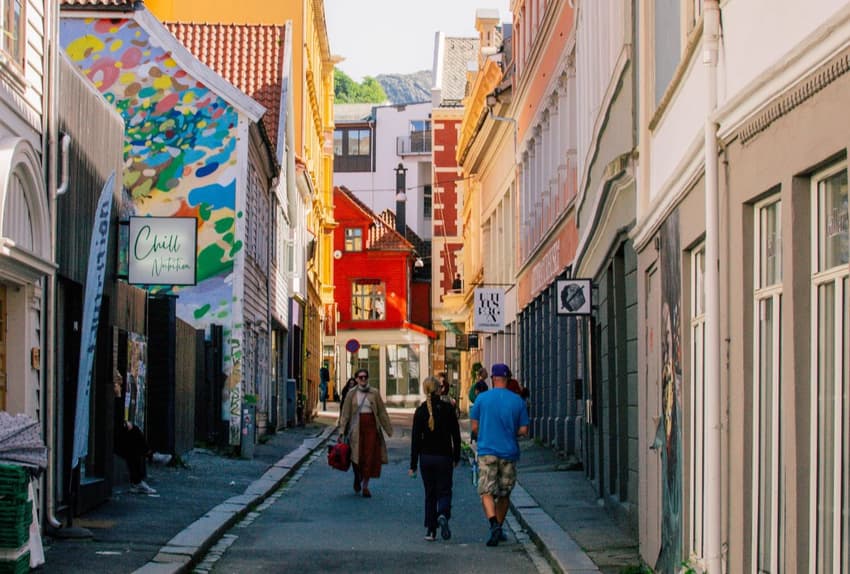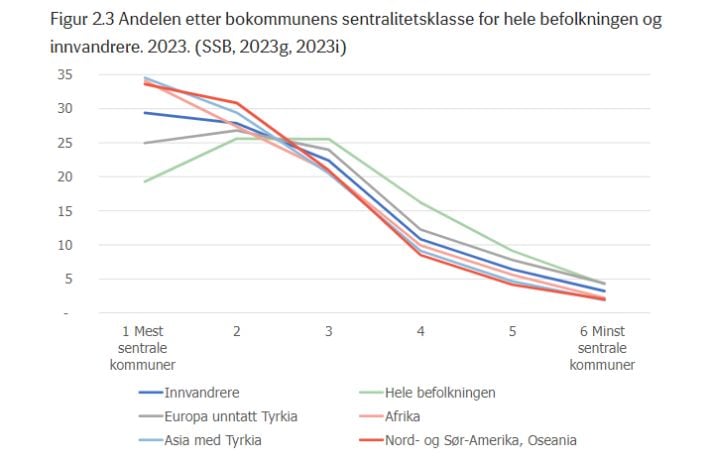Why more immigrants are settling in less central areas of Norway

Immigrants settling in Norway are increasingly choosing to stay in the less central parts of the country. Why is that so?
Typically, immigrants tend to flock towards more central areas of a country.
A new report on integration in Norway, published by the Directorate for Integration and Diversity (IMDi) on Monday, shows that the trend may be reversing and that foreigners in Norway may be choosing more rural areas.
READ MORE: How many immigrants does Norway have and where do they all live?
Norway's local authorities were ranked by centrality by IMDi on a scale of 1-6. Areas of the country with the shortest travel times to work and important nearby services were considered the most central.
The seven most central municipalities were Oslo, Lørenskog, Skedsmo, Bærum, Rælingen, Asker, and Drammen.
According to the most recent figures, three out of ten immigrants lived in one of the seven most central municipalities in the country in 2023. Looking at the population as a whole, the corresponding proportion is two out of ten.
What influences the decision on where to settle in Norway
One of the key factors is whether people have arrived in Norway as refugees and been settled in a particular municipality or whether they have arrived in connection with work or family immigration.
Refugees, for instance, are often distributed across the country as part of integration policies, which aim to spread out immigration/settlement to promote integration and cohesion in society.
However, those seeking education are drawn to central municipalities with universities and colleges.
Similarly, immigrant workers often find themselves in coastal municipalities, especially in northern Norway and the western regions, with a vibrant tourism industry and a need for seasonal work.
At the same time, the proportion of immigrants who live in Norway's central areas varies between different immigrant groups.
For example, immigrants from European countries are, to a lesser extent, concentrated in the most central municipalities than immigrants from other countries.
Why more foreigners are choosing to live less centrally
Since 2000 foreign nationals in Norway have begun to settle in less central parts of the country, with several factors behind the trend.
At its core, Norway's immigrant settlement patterns are a mix of individual preferences, government actions, as well as changing preferences and dynamics of different immigrant groups.
According to the latest IMDi report, newer arrivals in Norway tend to start off in less central regions. Moreover, more immigrants are choosing to remain in the municipality they originally moved to. This means more choosing to stay in the less central areas after initially moving.
Additionally, fewer foreigners are gravitating towards highly central areas than in previous years.
As mentioned earlier, refugees in Norway are distributed across all areas of the country due to integration policies, something which also contributes to more foreign nationals living in less central areas.
Within five years of arrival, many refugees relocate to the most central municipalities. This is particularly evident among those who arrived in Norway in 2011 and 2012.

Graph: Proportion according to the centrality class of the Norwegian municipality of residence for the entire population and immigrants, 2023, from the most central one (1) to the least central one (6). Source and screenshot: Statistics Norway, 2023g, 2023i, IMDi
Comments
See Also
Typically, immigrants tend to flock towards more central areas of a country.
A new report on integration in Norway, published by the Directorate for Integration and Diversity (IMDi) on Monday, shows that the trend may be reversing and that foreigners in Norway may be choosing more rural areas.
READ MORE: How many immigrants does Norway have and where do they all live?
Norway's local authorities were ranked by centrality by IMDi on a scale of 1-6. Areas of the country with the shortest travel times to work and important nearby services were considered the most central.
The seven most central municipalities were Oslo, Lørenskog, Skedsmo, Bærum, Rælingen, Asker, and Drammen.
According to the most recent figures, three out of ten immigrants lived in one of the seven most central municipalities in the country in 2023. Looking at the population as a whole, the corresponding proportion is two out of ten.
What influences the decision on where to settle in Norway
One of the key factors is whether people have arrived in Norway as refugees and been settled in a particular municipality or whether they have arrived in connection with work or family immigration.
Refugees, for instance, are often distributed across the country as part of integration policies, which aim to spread out immigration/settlement to promote integration and cohesion in society.
However, those seeking education are drawn to central municipalities with universities and colleges.
Similarly, immigrant workers often find themselves in coastal municipalities, especially in northern Norway and the western regions, with a vibrant tourism industry and a need for seasonal work.
At the same time, the proportion of immigrants who live in Norway's central areas varies between different immigrant groups.
For example, immigrants from European countries are, to a lesser extent, concentrated in the most central municipalities than immigrants from other countries.
Why more foreigners are choosing to live less centrally
Since 2000 foreign nationals in Norway have begun to settle in less central parts of the country, with several factors behind the trend.
At its core, Norway's immigrant settlement patterns are a mix of individual preferences, government actions, as well as changing preferences and dynamics of different immigrant groups.
According to the latest IMDi report, newer arrivals in Norway tend to start off in less central regions. Moreover, more immigrants are choosing to remain in the municipality they originally moved to. This means more choosing to stay in the less central areas after initially moving.
Additionally, fewer foreigners are gravitating towards highly central areas than in previous years.
As mentioned earlier, refugees in Norway are distributed across all areas of the country due to integration policies, something which also contributes to more foreign nationals living in less central areas.
Within five years of arrival, many refugees relocate to the most central municipalities. This is particularly evident among those who arrived in Norway in 2011 and 2012.

Join the conversation in our comments section below. Share your own views and experience and if you have a question or suggestion for our journalists then email us at [email protected].
Please keep comments civil, constructive and on topic – and make sure to read our terms of use before getting involved.
Please log in here to leave a comment.